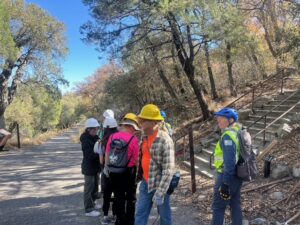Conservation
Conservation through Education is the mission of the Friends of Madera Canyon, incorporating a variety of programs and activities that promote concern and action toward conservation and preservation. It takes a lot of work to preserve the wilderness and to ensure that the splendors of Madera Canyon will be available and accessible to those who come after us.
Conservation, then, is an active and on-going part of what the Friends of Madera Canyon do. That work involves education about such things as: the long-term impact of trash, climate change, the value of the Proctor Native Plant and Pollinator Garden to the ecosystem of the Canyon, the role of research in the conservation and preservation of the Canyon, and the challenges those who would be good stewards of the Canyon face. Often, members of the public can become involved in conservation efforts by the ways in which they conform their uses of trails to the mindset of leaving only footprints.
Earth Day Celebration at Madera Canyon
With Friends of Madera Canyon
By Jean Martin
 It started with an idea by Dan White to involve the community in our work. Michele Gazica with the Preservation and Maintenance committee ran with it and transformed Dan’s idea into a wonderful celebration and collaboration with many other like-minded individuals and groups. On Saturday, April 26, we all gathered at the top of Mt. Wrightson parking area to naturalize, restore and protect some of the most impacted areas in Madera Canyon identified by the US Forest Service.
It started with an idea by Dan White to involve the community in our work. Michele Gazica with the Preservation and Maintenance committee ran with it and transformed Dan’s idea into a wonderful celebration and collaboration with many other like-minded individuals and groups. On Saturday, April 26, we all gathered at the top of Mt. Wrightson parking area to naturalize, restore and protect some of the most impacted areas in Madera Canyon identified by the US Forest Service.
 Wild Arizona registered all participants and provided hard hats, water and tools. Board to members who are not part of the Preservation and Maintenance Team showed up to support the event by checking in volunteers, handing out safety equipment and serving breakfast burritos supplied by Posada Java to the participants. The morning was also supported by the Knights of Columbus who assisted with parking. True Value Hardware donated protective eyewear, and Summit Hut provided financial support.
Wild Arizona registered all participants and provided hard hats, water and tools. Board to members who are not part of the Preservation and Maintenance Team showed up to support the event by checking in volunteers, handing out safety equipment and serving breakfast burritos supplied by Posada Java to the participants. The morning was also supported by the Knights of Columbus who assisted with parking. True Value Hardware donated protective eyewear, and Summit Hut provided financial support.
Dan White, President of Friends of Madera Canyon, talked about the first Earth Day launched by Gaylord Nelson on April 22, 1970. What started as a small event has reached 1 billion people in more than 193 countries. The volunteers at Madera Canyon included members of the Friends’ Preservation and Maintenance Team, the Green Valley Hiking Club, the Sahuarita Hiking Club, the Scouts of Troop 247 and their parents, Wild Arizona and Jim Beck, volunteer Forest Service Ranger. Dexter Kopas from Wild Arizona reviewed safety procedures and formed three teams to work on designated areas near the Old Baldy trail and upper picnic areas that have been overused and needed to be naturalized and protected from further impact.
 The teams worked diligently from 8:00 am until 1:00 pm and restored all the areas designated by the Forest Service. Although tired from the workout, everyone felt satisfied and shared a great sense of accomplishment. With all the recent cuts to the National Park Service, volunteer events are now needed more than ever to protect our public lands. A big THANK YOU to everyone who participated. We will make this an annual event! . Volunteers from the Forest Service, Sahuarita hiking Club, GV Hiking Club, Scout Troop 247, Wild Arizona participated in the event. Additional support was provided by True Value Hardware of Green Valley, Posada Java, the Knights of Columbus and our friends at Summit Hut.
The teams worked diligently from 8:00 am until 1:00 pm and restored all the areas designated by the Forest Service. Although tired from the workout, everyone felt satisfied and shared a great sense of accomplishment. With all the recent cuts to the National Park Service, volunteer events are now needed more than ever to protect our public lands. A big THANK YOU to everyone who participated. We will make this an annual event! . Volunteers from the Forest Service, Sahuarita hiking Club, GV Hiking Club, Scout Troop 247, Wild Arizona participated in the event. Additional support was provided by True Value Hardware of Green Valley, Posada Java, the Knights of Columbus and our friends at Summit Hut.



